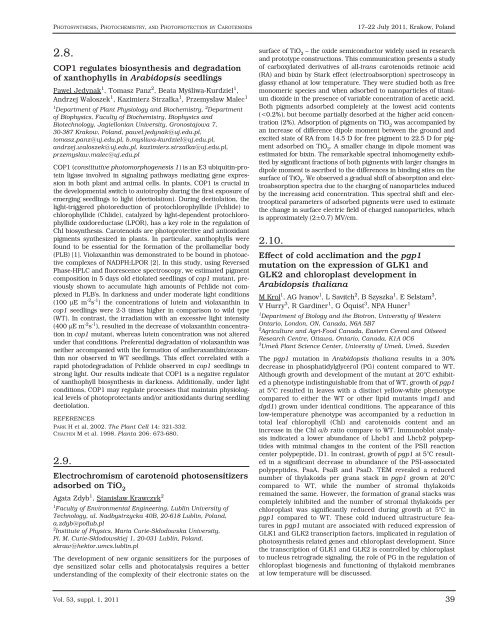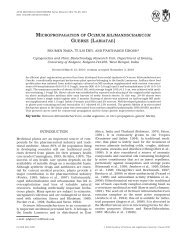ACTA BIOLOGICA CRACOVIENSIA
ACTA BIOLOGICA CRACOVIENSIA
ACTA BIOLOGICA CRACOVIENSIA
Create successful ePaper yourself
Turn your PDF publications into a flip-book with our unique Google optimized e-Paper software.
PHOTOSYNTHESIS, PHOTOCHEMISTRY, AND PHOTOPROTECTION BY CAROTENOIDS<br />
2.8.<br />
COP1 regulates biosynthesis and degradation<br />
of xanthophylls in Arabidopsis seedlings<br />
Pawel Jedynak1 , Tomasz Panz2 , Beata Myśliwa-Kurdziel1 ,<br />
Andrzej Waloszek1 , Kazimierz Strzałka1 , Przemysław Malec1 1 2 Department of Plant Physiology and Biochemistry, Department<br />
of Biophysics, Faculty of Biochemistry, Biophysics and<br />
Biotechnology, Jagiellonian University, Gronostajowa 7,<br />
30-387 Krakow, Poland, pawel.jedynak@uj.edu.pl,<br />
tomasz.panz@uj.edu.pl, b.mysliwa-kurdziel@uj.edu.pl,<br />
andrzej.waloszek@uj.edu.pl, kazimierz.strzalka@uj.edu.pl,<br />
przemyslaw.malec@uj.edu.pl<br />
COP1 (constitutive photomorphogenesis 1) is an E3 ubiquitin-protein<br />
ligase involved in signaling pathways mediating gene expression<br />
in both plant and animal cells. In plants, COP1 is crucial in<br />
the developmental switch to autotrophy during the first exposure of<br />
emerging seedlings to light (deetiolation). During deetiolation, the<br />
light-triggered photoreduction of protochlorophyllide (Pchlide) to<br />
chlorophyllide (Chlide), catalyzed by light-dependent protochlorophyllide<br />
oxidoreductase (LPOR), has a key role in the regulation of<br />
Chl biosynthesis. Carotenoids are photoprotective and antioxidant<br />
pigments synthesized in plants. In particular, xanthophylls were<br />
found to be essential for the formation of the prollamellar body<br />
(PLB) [1]. Violaxanthin was demonstrated to be bound in photoactive<br />
complexes of NADPH:LPOR [2]. In this study, using Reversed<br />
Phase-HPLC and fluorescence spectroscopy, we estimated pigment<br />
composition in 5 days old etiolated seedlings of cop1 mutant, previously<br />
shown to accumulate high amounts of Pchlide not complexed<br />
in PLB's. In darkness and under moderate light conditions<br />
(100 μE m -2 s -1 ) the concentrations of lutein and violaxanthin in<br />
cop1 seedlings were 2-3 times higher in comparison to wild type<br />
(WT). In contrast, the irradiation with an excessive light intensity<br />
(400 μE m -2 s -1 ), resulted in the decrease of violaxanthin concentration<br />
in cop1 mutant, whereas lutein concentration was not altered<br />
under that conditions. Preferential degradation of violaxanthin was<br />
neither accompanied with the formation of antheraxanthin/zeaxanthin<br />
nor observed in WT seedlings. This effect correlated with a<br />
rapid photodegradation of Pchlide observed in cop1 seedlings in<br />
strong light. Our results indicate that COP1 is a negative regulator<br />
of xanthophyll biosynthesis in darkness. Additionally, under light<br />
conditions, COP1 may regulate processes that maintain physiological<br />
levels of photoprotectants and/or anitioxidants during seedling<br />
deetiolation.<br />
REFERENCES<br />
PARK H et al. 2002. The Plant Cell 14: 321-332.<br />
CHACHDI M et al. 1998. Planta 206: 673-680.<br />
2.9.<br />
Electrochromism of carotenoid photosensitizers<br />
adsorbed on TiO2 Agata Zdyb1 , Stanisław Krawczyk2 1 Faculty of Environmental Engineering, Lublin University of<br />
Technology, ul. Nadbystrzycka 40B, 20-618 Lublin, Poland,<br />
a.zdyb@pollub.pl<br />
2 Institute of Physics, Maria Curie-Skłodowska University,<br />
Pl. M. Curie-Skłodowskiej 1, 20-031 Lublin, Poland,<br />
skraw@hektor.umcs.lublin.pl<br />
The development of new organic sensitizers for the purposes of<br />
dye sensitized solar cells and photocatalysis requires a better<br />
understanding of the complexity of their electronic states on the<br />
Vol. 53, suppl. 1, 2011<br />
surface of TiO 2 – the oxide semiconductor widely used in research<br />
and prototype constructions. This communication presents a study<br />
of carboxylated derivatives of all-trans carotenoids retinoic acid<br />
(RA) and bixin by Stark effect (electroabsorption) spectroscopy in<br />
glassy ethanol at low temperature. They were studied both as free<br />
monomeric species and when adsorbed to nanoparticles of titanium<br />
dioxide in the presence of variable concentration of acetic acid.<br />
Both pigments adsorbed completely at the lowest acid contents<br />
(












